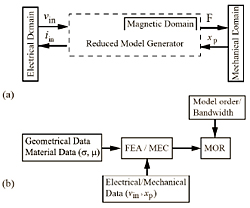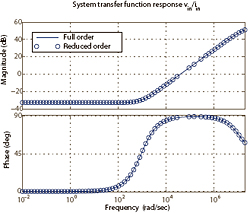Reduced-Order Modeling of Electromechanical Systems
Jonathan Sander with adviser P. L. Chapman
This project investigates order reduction of highly accurate physics-based models to ease computationally inefficient modeling of magnetic devices. Currently, we have successfully implemented model-order reduction techniques of linear and nonlinear stationary magnetic devices with the inclusion of eddy current losses. Magnetic equivalent circuit modeling has been extended to mesh grids to improve accuracy and maintain the physics of the system while reduction techniques have been used for fast computation. The reduced model-order results have matched their full order counterparts closely over a megahertz bandwidth, as seen in Figure 31.

Figure 32: (a) hybrid electromechanical system representation and (b) magnetic domain, reduced-model generator block diagram.
Current efforts are aimed at incorporating hysteresis and saturation effects in the current models while maintaining a computationally manageable system. These effects introduce challenging nonlinearities in the model-order reduction algorithm which may prevent “pre-compiling” of the model based on material and geometric properties. The final objective, however, will still consist of a model-order reduced system or set of piecewise systems that maintain the accuracy of physics based models without the intensive computational overhead.
